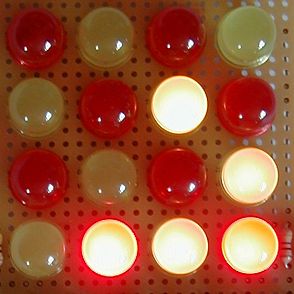BlinkyEnglish: Difference between revisions
From BlinkenArea Wiki
ArneRossius (talk | contribs) No edit summary |
ArneRossius (talk | contribs) No edit summary |
||
| (2 intermediate revisions by the same user not shown) | |||
| Line 1: | Line 1: | ||
__NOEDITSECTION__ | __NOEDITSECTION__ | ||
{{Infobox | {{Infobox | ||
|Jahr= | |Name=Blinky | ||
|Bild=Blinky_thumb2.jpg | |||
|Jahr= 2005 | |||
|Pixel= 16 (4x4) | |Pixel= 16 (4x4) | ||
|Farben=16 | |||
|Leuchtmittel=10mm LEDs | |||
|Leistung= | |Leistung= | ||
|Kontakt= [[User:ArneRossius|Arne Rossius]] | |Kontakt= [[User:ArneRossius|Arne Rossius]] | ||
|Webseite= | |Webseite= | ||
}} | }} | ||
The idea of Blinky is stolen from [http://www.siwawi.arubi.uni-kl.de/avr_projects/matrix44/ a website], so I used the same name for this project. As the new firmware for Blinky is not available at that site, I decided to create a completely new one, useing a smaller microcontroller and adding a few features. It consists of 16 red and yellow 10mm LEDs that are placed in an alternating pattern to form a 4x4 pixel matrix. They can be lit in 16 different brightness values. The desired operating mode can be choosen with 2 keys that can be pressed either short or long. In addition, there is an RS232 port to receive streams from a PC and an 1Hz clock source (taken from the clockwork of an "analog" clock). | The idea of Blinky is stolen from [http://www.siwawi.arubi.uni-kl.de/avr_projects/matrix44/ a website], so I used the same name for this project. As the new firmware for Blinky is not available at that site, I decided to create a completely new one, useing a smaller microcontroller and adding a few features. It consists of 16 red and yellow 10mm LEDs that are placed in an alternating pattern to form a 4x4 pixel matrix. They can be lit in 16 different brightness values. The desired operating mode can be choosen with 2 keys that can be pressed either short or long. In addition, there is an RS232 port to receive streams from a PC and an 1Hz clock source (taken from the clockwork of an "analog" clock). | ||
Latest revision as of 00:08, 13 June 2010
| zur Projektübersicht | |

| |
| Jahr | 2005 |
| Anzahl Pixel | 16 (4x4) |
| Graustufen / Farben | 16 |
| Leuchtmittel | 10mm LEDs |
| Leistungsaufnahme | |
| Kontaktperson | Arne Rossius |
| Projekt-Website | |
The idea of Blinky is stolen from a website, so I used the same name for this project. As the new firmware for Blinky is not available at that site, I decided to create a completely new one, useing a smaller microcontroller and adding a few features. It consists of 16 red and yellow 10mm LEDs that are placed in an alternating pattern to form a 4x4 pixel matrix. They can be lit in 16 different brightness values. The desired operating mode can be choosen with 2 keys that can be pressed either short or long. In addition, there is an RS232 port to receive streams from a PC and an 1Hz clock source (taken from the clockwork of an "analog" clock).
Features/Modes
- Play "hard-coded" animations (left button, short press)
- Several commands for animations: SET, FADE, LOOP, LOOPEND, WAIT
- about half the flash (1024 Bytes) is available for animations
- Play a stream received via RS232 (left button, long press)
- MCUF protocol
- 19200 Baud (8 data bits, 1 stop bit, no parity)
- frame size must be 4x4
- maxval must be either 0x0F or 0xFF (0xFF values are internally shifted right 4 places)
- internal timeout if nothing is received within some milliseconds (prevents becoming out of sync)
- Show a BCD clock (right button, short press)
- vertical "digits"
- 24 hours clock
- 1HZ clock source on the back of the circuit board
- Set the clock (right button, long press)
- each "digit" is set independantly
- left button = set, right button = next digit
- the internal second couter is only reset when the "set"-button is pressed during setting the minute 1's
- 0000 is displayed as 1111 in this mode to see which digit is being set (blinking)
Schematic/Firmware
- Schematic (PNG)
- Schematic (Eagle)
- Firmware v0.5 (ZIP)
- Firmware v0.6 (ZIP), 22C3 Version 22C3 version (2 new animations, no code changes)
- Firmware v0.7 (ZIP), mit Code fuer including code for BlinkyLamps


